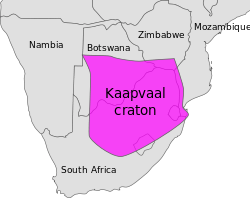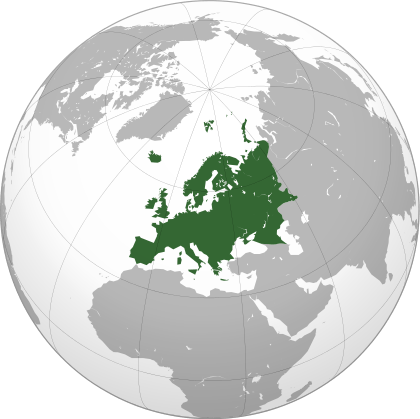Vaalbara
| Vaalbara today | ||||
|---|---|---|---|---|
|
Vaalbara is the Earth's theorized first supercontinent.[1] It was a complete supercontinent by 3,100 million years ago. Vaalbara formed possibly beginning 3,600 million years ago and was broken apart by about 2,800 million years ago.[1]
Vaalbara consisted of the eastern South African Kaapvaal craton joined with the Pilbara craton in northwest Western Australia.[1] (The name Vaalbara is derived from the last four letters of each craton's name.)
It is uncertain when Vaalbara began to break up; geochronological and palaeomagnetic evidence show that the two cratons had a rotational 30° latitudinal separation in the time period of 2.78 to 2.77 billion years ago, which indicates they were no longer joined after ~2,800 million years ago.[2]
Continental plates have periodically collided and assembled in geologic periods of orogenesis (mountain building) to form supercontinents. The cycle of supercontinent formation, breakup, dispersal and reformation by plate tectonics occurs every 450 million years or so.
Evidence for Vaalbara
South Africa's Kaapvaal craton and Western Australia's Pilbara craton have similar early Precambrian cover sequences.[3] Kaapvaal's Barberton granite-greenstone terrane and Pilbara's eastern block show evidence of four large meteorite impacts between 3,200 to 3,500 million years ago.[4] (Similar greenstone belts are now found at the margins of the Superior craton of Canada, and across the cratons of the former Gondwana and Laurasia continents.)[2]
The high temperatures created by the impact’s force fused sediments into small glassy spherules.[5]:27 Spherules of 3,500 million years old exist in South Africa and spherules of a similar age have been found in Western Australia,[5]:27 they are the oldest-known terrestrial impact products.[6] The spherules resemble the glassy chondrules (rounded granules) in carbonaceous chondrites, which are found in carbon-rich meteorites and lunar soils.[5]:27
Remarkably similar lithostratigraphic and chronostratigraphic structural sequences between these two cratons have been noted for the period between 3,500 to 2,700 million years ago.[7] Paleomagnetic data from two ultramafic complexes in the cratons showed that at 3,870 million years the two cratons could have been part of the same supercontinent.[7] Both the Pilbara and Kaapvaal cratons show extensional faults which were active about 3,470 million years ago during felsic volcanism and coeval with the impact layers.[7]
Supercontinent formation
Cratons are the masses of rock composing the basic, initial structure of continents; they have remained stable for billions of years throughout the process of the ocean crust being continually created and destroyed.[1] Continental plates, containing the ancient cratons, have periodically collided and assembled in geologic periods of orogenesis (mountain building) to form supercontinents.[1] A supercontinent is a landmass composed of more than one craton.
Mechanism for breakup of supercontinents
Supercontinents act as thermal lids, blocking the escape of Earth's internal heat, so the asthenosphere overheats.[1] Eventually the lithosphere begins to dome upward, it cracks, magma wells upward and fragments of the supercontinent slide off the overswell. The East African Rift valleys are a modern-day example of this breaking apart.[8] This cycle – the Wilson Cycle – of supercontinent formation, breakup, and dispersal, followed by convergence and patching, through plate tectonics occurs every 450 million years or so.[5]:90
See also
References
- ↑ 1.0 1.1 1.2 1.3 1.4 1.5 "Supercontinents". enotes.com Science. pp. 1–2. Retrieved February 28, 2010.
- ↑ 2.0 2.1 "Paleogeography: Paleogeology, Paleoclimate, in relation to Evolution of Life on Earth". December 30, 2008. p. 2. Retrieved February 28, 2010.
- ↑ Kock, De; Olivier, Michael (August 25, 2008). "Paleomagnetism of selected neoarchean-paleoproterozioc cover sequences on the Kaapvaal Craton and implications for Vaalbara". UJDigiSpace@The University of Johannesburg: 1. Retrieved March 17, 2010.
- ↑ Byerly, Gary R; Lowe, Donald R; Wooden, Joseph L; Xie, Xiaogang (2002). "An Archean Impact Layer from the Pilbara and Kaapvaal Cratons". Science 297 (5585): 1325–7. Bibcode:2002Sci...297.1325B. doi:10.1126/science.1073934. PMID 12193781. Retrieved March 27, 2010.
- ↑ 5.0 5.1 5.2 5.3 Erickson, Jon (1993). Craters, Caverns and Canyons – Delving Beneath the Earth’s Surface. ISBN 0-8160-2590-8.
- ↑ Lowe, Donald R; Byerly, Gary R (January 1986). "Early Archean silicate spherules of probable impact origin, South Africa and Western Australia". Geology (Geological Society of America) 14 (1): 83. Bibcode:1986Geo....14...83L. doi:10.1130/0091-7613(1986)14<83:EASSOP>2.0.CO;2. Retrieved March 17, 2010.
- ↑ 7.0 7.1 7.2 Zegers, TE; Ocampo, A (August 5–7, 2003). "Vaalbara and Tectonic Effects of a Mega Impact in the Early Archean 3470 Ma". Nordlingen; Germany: Third International Conference on Large Meteorite Impacts. p. 1. Retrieved March 17, 2010.
- ↑ "Plate Tectonics: Lecture 3, The Wilson Cycle: Rifting and the Development of Ocean Basins". p. 1. Retrieved March 7, 2010.
- Bailey, R.C., Cruden, A.R., and B. Nitescu. (2006) "Crustal structure and implications for the tectonic evolution of the Archean Western Superior craton from forward and inverse gravity modeling." Tectonics, vol. 25. Online Abstract: http://www.agu.org/pubs/crossref/2006/2004TC001717.shtml
- Dann, J., M. J. de Wit, S. H. White, and E. Zegers. (1998) Vaalbara, Earth's oldest assembled continent? A combined. structural, geochronological, and palaeomagnetic test." Online: http://www.geo.uu.nl/Research/Paleomagnetism/publications/Zegers98b.pdf
- Wingate, M.T.D. (1998) “palaeomagnetic test of the Kaapvaal-Pilbara (Vaalbara) connection at 2.78 Ga.” South African Journal of Geology; December 1998; v. 101; no. 4; p. 257-274 Australian National University, Research School of Earth Sciences, Canberra, Australia. Online Abstract: http://sajg.geoscienceworld.org/cgi/content/abstract/101/4/257
External links
- Palaeos.com: General earth history
| |||||||||||||||||||||||||||||||||


.svg.png)
.svg.png)
.svg.png)
.svg.png)


.svg.png)
.svg.png)
.svg.png)
.svg.png)
.svg.png)